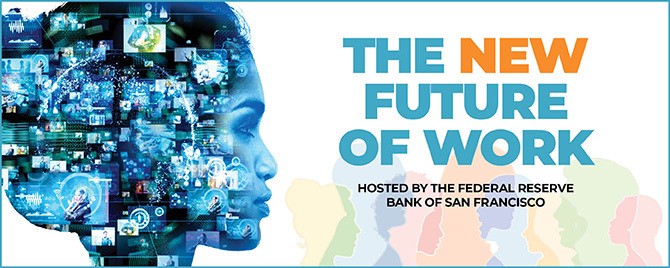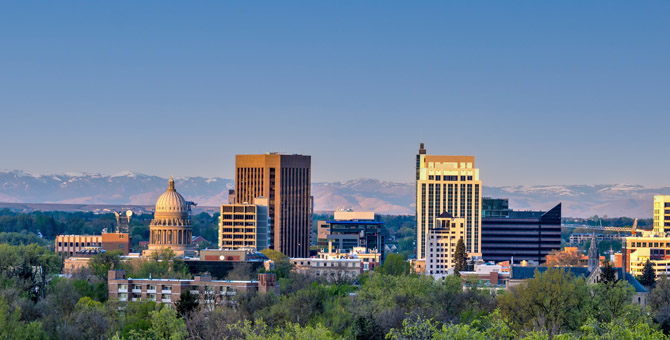During the Spanish Flu pandemic a century ago, people fled cities for the relative safety of less populated areas. This prompted a prediction that the “death” of cities was upon us. Of course, that prediction didn’t pan out—the 1920s was an era of growth for many urban centers.
But the current COVID-19 pandemic has again called into question the health, stability, and longevity of our urban areas. With the increase in remote work, people have other options for where they live and call home. The question, says SF Fed President Mary Daly, is did those who foresaw the decline of cities “finally get it right 102 years later?”
To help answer the question of the fate our cities, we brought together a panel of experts for our second conversation on The New Future of Work. President Daly was joined by Keisha Lance Bottoms, mayor of Atlanta; Earvin “Magic” Johnson, NBA legend and longtime investor in urban communities; Lauren McLean, mayor of Boise, Idaho; and Enrico Moretti, economics professor at the University of California, Berkeley.
Here are our top takeaways from the conversation. The following quotes are lightly edited for clarity.
1. There’s reason to be bullish on cities
“Humans have flocked to cities for thousands and thousands of years. We’ve withstood pandemics, economic crises, wars, and we still keep coming back. So I really believe that while cities will look different, potentially, after this, we all have reason to be bullish on cities.”
– Lauren McLean
“I’m very bullish on cities and it all comes back to one single reason: I’m bullish on people… People, we want to be together. We understand the virtuous cycle we all can do. And we understand that together we’re better. That if we collaborate, if we connect with each other, we can build resilient, sustainable places where all of our people can live.”
– Mary C. Daly
2. Making smart policy choices isn’t “rocket science”
“I think that the issue of overcrowding and the cost of living really reflects policy choices on the part of cities. There are wise and smart investments cities can make: for example, to invest in transit. We can learn from European cities. It’s not like rocket science. We know that if you invest in transit, we will get results, we will reduce congestion.”
– Enrico Moretti
3. We need to do better by marginalized communities
“The Paycheck Protection Program did not trickle down to the Black and Brown community. So when you think about Black America, we lost over 400,000 Black businesses because we didn’t have relationships with banks or credit unions who got the money, or they said that we didn’t have enough employees… We needed those Black-owned businesses to survive because they provide so many services to our community.”
– Earvin “Magic” Johnson
4. Partnering with the private sector is one way forward
“I have a body that I meet with once a quarter, the Atlanta Committee for Progress. There are numerous Fortune 500 companies headquartered in Atlanta. Many of these CEOs, representatives of philanthropic organizations, colleges, and universities meet with me… so I have the luxury of having dreams about things that I have no idea how they will be funded in our city budget. But if I’m able to take it to our corporate community, it gives me a little more flexibility.”
– Keisha Lance Bottoms
5. We need to be willing to make investments
“Folks are coming here [from the coasts]… but then are more hesitant when it comes to a willingness to pay property taxes or make other investments. As a city, we have so few financial tools to make sure that we can invest in mobility so people can move from work to home more easily, to invest in open spaces and parks… to make sure that our schools have the space they need.
“One of the things we’re often up against is that ability to keep up with infrastructure and also protect what we love about this place.”
– Lauren McLean
6. The urban-rural divide isn’t as great as we think
“What we’re seeing, especially in the light of COVID-19, [is that] many of the challenges we have in our rural communities are the same ones we have in our urban communities—whether it’s access to broadband, whether it’s access to fresh food or medical care. That’s why there’s going to be a need for consistent policies [so] that no matter where we decide to live, we can at least feel as if we all have an equal opportunity to be successful.”
– Keisha Lance Bottoms
7. Education is key
“If you look at the data, there’s no question that the cities that have done the best over the past two decades are the cities that have the highest share of well-educated workers in the workforce.
“Cities where you see a lot of workers with college degrees and master’s degrees are also the cities where the labor incomes for workers with high school degrees or less have grown the most.
“I think there’s a growing body of economic research that points to the fact that a dollar invested in education—whether it’s an elementary school, middle school, high school, community college, college–in the long run has a much higher return for the community.”
– Enrico Moretti
8. Be an optimist
“During the course of the past several months, I’ve kept [my ancestors’] picture near me. They were once enslaved and something about hoping and dreaming for a better tomorrow has allowed me to now be the mayor of Atlanta. I truly believe that I owe that to my children and my children’s children. If I’m not optimistic and if I don’t work and get up each and every day believing that there is something better in store for us, then I know my children’s future won’t exist.”
– Keisha Lance Bottoms
Please check back for information on upcoming New Future of Work events.

Image credit: knowlesgallery via iStock.
You may also like:
The views expressed here do not necessarily reflect the views of the management of the Federal Reserve Bank of San Francisco or of the Board of Governors of the Federal Reserve System.
